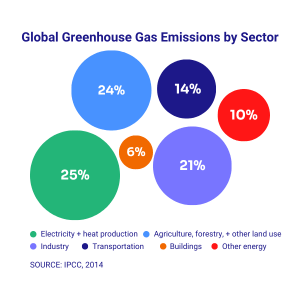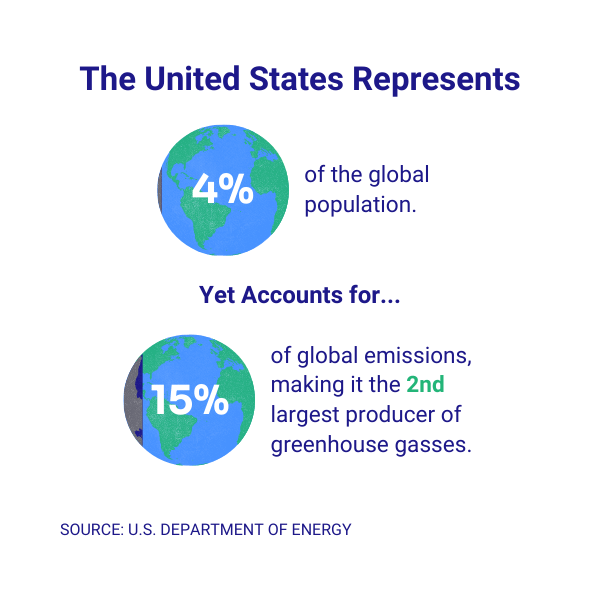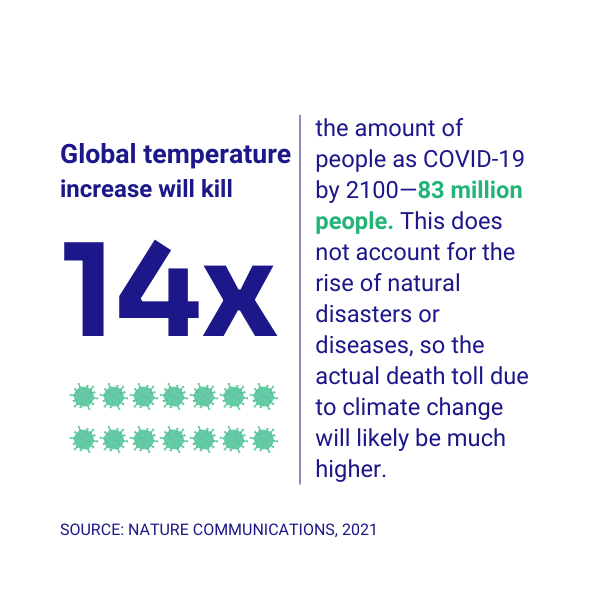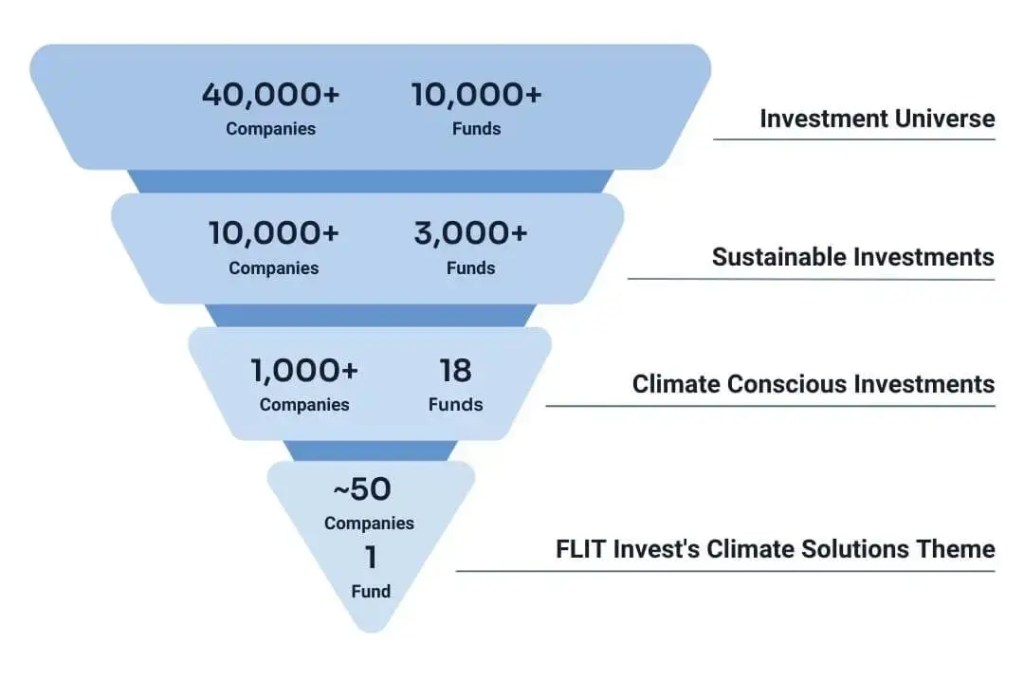An Introduction to the Climate Crisis
The climate crisis is one of the most impactful existential threats we face today. The rate of climate change has moved into a state of emergency, yet it is still largely misunderstood and unaddressed. Climate change refers to the “long-term shifts in temperatures and weather patterns.” These shifts can occur naturally, as we experience with seasons, or they can be the consequence of human activity. Scientists declare that we have entered a new geological age, the Anthropocene, during which human activity has been the dominant force in climate and environmental change. The problem is that human activity is causing climate change to occur so rapidly that we are threatening the stability of the natural world. It affects every living organism on the planet and threatens to collapse ecosystems in every region.
The consequences of human activity on climate change can be understood primarily by greenhouse gas emissions (GHGs). GHGs are a group of atmospheric gases that retain and reflect heat; they prevent the Earth from being too cold to inhabit. However, GHG emissions are so high and retain too much heat, and the Earth is warming towards inhabitable temperatures. GHG emissions have been exponentially increasing: 50% of total carbon dioxide (CO₂) emissions have occurred in the last 40 years (IPCC 2018). Tackling GHG emissions requires a two-pronged approach: reduce emissions and increase GHG removal. Each atmospheric gas has different chemical properties, so removal processes vary. CO₂, for example, can be absorbed by carbon sinks such as rainforests and oceans, but deforestation and rising temperatures are depleting carbon dioxide removal. Not only are GHG emissions increasing, but the means also to take them out of the atmosphere are decreasing, both due to human activity.
How did we get here?
Climate change driven by human activity is not a new thing. Since the 1800s, human activity has been the primary propellant of climate change. Great Britain led globally in industrial advancements, fueling the power industry by burning fossil fuels, namely coal. The Industrial Revolution was a time of innovation and development; new inventions depended on coal-based energy power, particularly the versatile and widely used steam engine. The mass burning of coal and other fossil fuels during that time had dire environmental health consequences. Burning coal releases various atmospheric gases, including sulfur dioxide, mercury, and GHGs like carbon dioxide and nitrogen oxides. These gases mixed with fog created “smog” (smoke and fog), a major environmental and public health issue. One of the earliest identifiable consequences of climate change was “The Great Smog of London” in 1952, which led to thousands of deaths over 5 years. Air pollution and respiratory diseases continue to be correlated today – the recent COVID-19 pandemic has demonstrated this. The Industrial Revolution paved the way for a century of global innovation, landmarking the 1950 Great Acceleration. From here, the Anthropocene commenced, and a dramatic increase in human activity affecting the planet ensued.
Addressing the climate crisis is essential for the chance of a just and sustainable future. Achieving gender equality, a green economy, or humanitarian justice is impossible under ecological collapse—FLIT’s investment theme, Climate Solutions, allows investors to invest their money into various adaptation and mitigation strategies and resilience research. Without action, there will be no solution.
Greenhouse Gas Emissions by Sector
To address GHG emissions, we must first understand their source. The IPCC reports global GHG emissions by sector; the report outlines clearly the areas of human activity most in need of climate solutions. Energy (35%), agriculture (24%), and transportation (14%) sectors account for most GHG emissions; this is the consequence of overreliance on fossil fuels, inefficient practices, poor waste management, and competition for resources. We must explore these challenges to reduce GHG emissions.
Figure 1. Global Greenhouse Gas Emissions by Economic Sector (2014).

Electricity and heat production make up 25% of total emissions, and other energy-related sources make up a further 10%. These emissions are unsurprising given that 80% of energy production involves burning fossil fuels. Fossil fuels are finite resources: as the world continues to utilize and exploit fossil fuel reserves, they will eventually run out. The continued reliance and inefficient use of fossil-fuel-based energy is severe neglect of responsibility by energy companies and governments across the globe. Transitioning to renewable energy is pivotal in curbing greenhouse emissions and staying on track with the 2015 Paris Agreement to keep global warming to a maximum of 1.5°C.
Agriculture, forestry, and other land use account for 24% of GHG emissions. Rearing livestock is a significant source of methane emissions, and the intense meat and dairy diets adopted worldwide only worsen this. Modern agriculture also uses unsustainable, short-term profit-maximizing practices to increase crop yield. For example, nitrogen-based fertilizers are widely used to increase crop success but have damaging environmental consequences for aquatic life. At the same time, there is deforestation. Forests absorb and sequester carbon dioxide from the atmosphere; without them, the Earth would keep getting warmer. Increased demand by agricultural industries for land use only makes deforestation rates – the industry already takes up over a third of Earth’s habitable land. A high-profile example of deforestation for agriculture can is the Amazon Rainforest. According to 2021 estimates, agricultural practices make up 91% of the land from deforestation in the Amazon Rainforest. The competition for natural resources continues to degrade the environment.
The transportation sector accounts for 14% of global GHG emissions, as burning fossil fuels powers the most conventional forms of transport. In the US, transportation accounts for 27% of GHG emissions. A combination of pollutive fuels, inefficient vehicles, driving-dependent societies (due to lack of infrastructure or safety for public transport), and lack of streamlined operating practices contribute to high emissions. Public transport is an excellent alternative to private vehicles. However, the transport sector remains dominated by gas-powered engines, and globally, less than half of people have access to safe, accessible, and reliable public transport. Electric vehicles are also a great solution to reducing transport emissions, but we remain years away from being affordable and with the proper charging infrastructure. The transport sector needs to make changes at an infrastructural level to reduce emissions from private and public vehicles.
Rising Temperatures
The climate varies from region to region, and so it is commonly misunderstood that heat waves and harsh winters are, in fact, Earth’s red flags. Global warming causes climate change, the consequences of which can manifest in hotter, dryer summers or wetter, harsher winters. To standardize and understand what is meant by rising temperatures, scientists calculate the average temperature rise since the beginning of the Industrial Revolution by region. NASA reports that the Earth’s average temperature has increased by 1.2°C or 2.1°F. In isolation, these figures seem inconsequential, but this average reflects extreme variations in both hot and cold weather. Some areas are now much colder than usual, others much hotter.
Today’s rising temperatures are of great concern. Rising global temperatures will negatively impact ecosystems that support and maintain our lives. The impact of delaying emission reduction is that the Earth will continue to warm and perhaps to an inhabitable level. What we emit today will determine our future, just as how today we feel the consequences of emissions past. According to the 6th IPCC Assessment Report on the current state of the climate crisis, even if we stop using fossil fuels today, our emissions thus far have locked us in for eventual warming of 1.5°C in the coming decades. The severity of just 1.0 – 2.0°C change is internationally recognized. In 2015, 175 world leaders signed the Paris Agreement as an international commitment to address and mitigate climate change, aiming to keep global warming to a maximum of 2.0°C. The Paris Accords were momentous, but according to Climate Action Tracker, not a single country has comprehensive action compatible with the 1.5°C target.
Figure 2 shows a graph comparing the changes in regional average temperatures given a global average rise of 1.5°C, 2.0°C, and 4.0°C. Large areas of land are nearing 10.0°C warmer, and in the 2.0°C rise scenario, places facing extreme precipitation, heatwaves, and droughts will be far more common.
According to NASA, between 184 and 270 million more people will be exposed to water scarcity issues with 2.0°C global warming than 1.5°C. We are currently on track to reach a 3.2°C increase in temperature by 2100. Based on our actions in mitigating climate change, different futures lie ahead.
Figure 2: Change in Average Temperature in the +1.5C, +2.0C, and +4.0C Scenario.

Climate Justice
The climate crisis is a threat to everyone, but some face this threat sooner and with greater consequences than others. High-income economies (as determined by the World Bank) emit one-third of the world’s total emissions despite making up only 16% of the global population (OWID inequality emissions). Emission per capita is a clear demonstration of global climate injustice. For every 4,434 metric tons of CO₂ emissions added beyond 2020 rates, one person will die: this is equivalent to the current life emissions of 3.5 Americans, 9.4 Britons, 25.8 Brazilians, or 146.2 Nigerians. The global average would be 12.8 people. Advanced economies are more responsible for reducing GHG emissions and mitigating the climate crisis.
Unfortunately, the relationship between high emitting countries and their commitment to addressing climate change is not always in the direction we hope. In 2018, the US was the second leading emitter of greenhouse gases but only sent 78 delegates to the COP25 Climate Summit in Madrid. In contrast, lesser polluting nations like Cote d’Ivoire rack up attendance of 348 delegates (OWD total GHG, Carbon Brief). The equatorial region is experiencing the climate crisis first – the impact of climate change on the Tropics is happening now and is pushing these nations to their limits. It is being left up to them to advocate for climate adaptation and mitigation strategies caused by intense GHG emissions from advanced economies on the other side of the globe. Emissions anywhere threaten stability everywhere.

We broadly understand climate change through its devastating effects on the natural world, but the climate crisis is also a humanitarian issue. Climate change will exacerbate existing inequalities for current and future generations . The human rights organization Amnesty International believes that “the failure of governments to act on the climate crisis in the face of overwhelming scientific evidence may well be the biggest intergenerational human rights violation in history.” Climate change increases inequalities: between developed and developing nations, on an ethnic and class level, by gender, between generations, and against indigenous communities.
Climate change increases intersectional inequalities. In North America, this is particularly true between different ethnicities and classes, where the racial wealth gap is stark. Communities of color and low socioeconomic status experience excessive exposure to contaminated air, water, and toxic chemicals, as often cheaper housing, is near power plants and refineries. They are more likely to suffer from respiratory diseases and cancers, particularly older Black and Hispanic people, due to air pollution exposure. Disproportionate exposure has severe knock-on effects for these communities, who face high medical bills to treat these environmental health issues.
Globally, climate change also disproportionately affects women and girls, given that they face marginalization in many countries. They face barriers in financial autonomy, land ownership, technological resources, and basic protection from harm. Women and girls are less able to adapt to climate change and, therefore, are more at risk when climate-related events hit. Some communities even experience inequality in the bid to tackle climate change – indigenous communities have a long history of being colonized, murdered, and displaced across the globe.
Indigenous communities offer great power in understanding the natural environment and conserving biodiversity and natural resources, yet rarely receive a seat at the table of climate decision-making. They have a close connection with nature and have livelihoods and cultural identities built upon generational lands. More and more, indigenous people, such as the Sengwer people of Embobut Forest, Kenya, are being forcefully removed and evicted from their land in the name of climate-related initiatives. To reduce deforestation, the Kenyan government is forcefully evicting the Sengwer people from their ancestral lands without consultation. Climate solutions must be inclusive and respect present and historical inequalities, and not just shaped by and for the white and wealthy.
Deathly Consequences
The World Health Organization (WHO) estimates that more than 13 million global annual deaths are due to avoidable environmental causes, including the climate crisis. Life’s essential resources like air, water, food, and shelter depend on climate stability. When vital resources are impacted or threatened, the human population is left vulnerable to food scarcity, injury, and severe illness. Dealing with these consequences is an extreme burden at a personal, national, and international level, and the inequality of climate change is most obvious in this way. The WHO estimates that the health costs of climate change will be 2-4 billion USD annually until 2030.

As global warming increases the frequency of extreme weather events such as heatwaves, droughts, floods, and storms, the climate death toll is rising. In recent years, the US, Australia, and the Amazon Rainforest faced wildfires that destroyed ecosystems and livelihoods and contributed to a significant amount of air pollution. In South America, Chile has been experiencing drought for over a decade; meanwhile, an extended dry spell in Central America has exposed 2.2 million people to food insecurity and caused a 500% increase in migration from the affected areas. The climate crisis is now contributing to the global refugee crisis, with thousands fleeing their homes for safety or deserting neighborhoods due to repeated crop failure. It is not just in the ‘typical’ hot spots for natural disasters either; climate refugees are in the Global North too, with the US and UK both reporting their own climate refugees. In Southern Africa, Cyclones Idai and Kenneth killed hundreds of people and left hundreds of thousands more in need. Flooding in Europe left hundreds of people dead in the summer of 2021, and now the region faces record-breaking heatwaves, drought, and wildfires in the summer of 2022. Other deaths are associated with GHG emissions rather than the consequence of global warming. In India, around a million deaths occur annually due to air pollution, and worldwide, plastic poisoning is on the rise. We are feeling the impact of our negligence today, and if we continue our current trajectory, we could face irreversible consequences.
By 2100, at least 83 million deaths will be directly caused by the increased global temperatures. Climate change will become a leading cause of excess deaths at 4.6 million per year. That would rank climate change ahead of outdoor air pollution (3.4 million) and just below obesity (4.7 million). To protect humanity, we need to focus on limiting global warming to 1.5°C by and investing in climate solutions that support adaptation, mitigation, and resilience.
Introduction to Solutions to the Climate Crisis
What does the UN say will be necessary to combat the climate crisis?
Addressing the climate crisis is paramount for all future development. Any effort towards just and sustainable development is in vain if we do not face up to the much-needed and direct climate action. In 2019, the UN Secretary-General called for total societal mobilization for a “Decade of Action” towards the Sustainable Development Goals (SDGs) 2030 agenda (UN web). This decade of action demands that we be the generation that will win the race against climate change and hold leaders to account to deliver on their commitments. Almost 200 countries have set nationally determined contributions per the Paris Agreement to address climate change. According to the IPCC 2022 report, changes are happening, albeit disorganized and demure. Governments are putting effort in the right boxes that greenwash appearances – impact needs to occur at a macro level and create momentum for systemic change. Governments must implement and monitor policies that adequately offer adaptation, mitigation, and resilience-building strategies toward the climate crisis. At national and international levels, this must heed the slogan of the UN SDGs and leave no one behind by focusing on the inclusion of marginalized groups so that the climate crisis (and its solutions) does not marginalize them further.
The UN recognizes the critical nature of the climate crisis dedicating one goal specifically to it – SDG 13 Climate Action – amongst other environmental targets interspersed in the goals. SDG 13 aims to “take urgent action to combat climate change and its impacts”. Perhaps the most succinct goal, SDG 13 has three main targets:
- Strengthen resilience and adaptive capacity to climate-related hazards and natural disasters.
- Integrate climate change measures into national policies, strategies, and planning.
- Improve education on human and institutional capacity for climate change mitigation and adaptation.
It recognizes the need for action at a policy and infrastructural level while also understanding that this commitment will require financial backing. The UNFCCC advocated for a commitment from developed countries to jointly mobilize a sum of $100 billion annually by 2020 to address the climate needs of developing nations – they called this the Green Climate Fund. Addressing the climate crisis can only happen with collaborative efforts and regarding those most affected – low-income nations, women, youth, and local marginalized communities. Other goals addressing the climate crisis include SDG 7 Affordable and Clean Energy, SDG 11 Sustainable Cities and Communities, SDG 12 Responsible Consumption and Production, SDG 14 Life on Land, and SDG 15 Life Below Water. They each address a different area related to environmental degradation, whether it be reducing GHG emissions with renewables (SDG 7) or combatting deforestation and desertification with comprehensive national policies (SDG 14). Solutions to the climate crisis require immediate and drastic action. Development must consider people, the planet, and profit to achieve a just and sustainable world – that is the triple bottom line of sustainability.
Climate solutions have three aspects: mitigation, adaptation, and resilience building.
- Mitigation considers the prevention and reduction of the harmful effects of climate change. This primarily takes the form of reducing GHG emissions in key sectors like energy and transportation by increasing energy efficiency and transitioning to renewables. According to IEA, as of 2021, renewable energy accounts for 30% of total global energy production, trending towards further increases. This increase is positive news, but mitigation action must be seen more broadly across industries.
- Adaptation looks at the everyday causes and consequences of climate change. This action includes systemic level change, like implementing water-saving strategies in the face of heatwaves and in anticipation of drought. Water infrastructure and technologies are vital in adapting to ever-growing water scarcity and can operate locally or nationally.
- Resilience building develops how communities can bounce back and resist the devastation caused by the climate crisis. This approach includes advancements in digital infrastructures to enhance communication, relief response, and resource management – digital technologies are critical to improving the climate resilience of critical infrastructure. Resilience building can also include adopting more sustainable agricultural practices such as crop rotation, proper storage and transport of produce, and natural fertilizers. These practices build resilience to the changing climate and incoming agricultural policies. Empowering people to reduce their vulnerability and offering greater social buffers in times of need goes a long way in supporting populations through the climate crisis.
For Climate Solutions, FLIT concentrates on measurable climate solutions in transport solutions, resource efficiency and waste management, water infrastructure and technologies, and digital infrastructure. To address the importance of reducing GHG emissions in the energy sector, we offer a specific investment theme, Green Energy.
FLIT Invest Climate Solutions Portfolio
There are multiple SDGs with climate goals and indicators in their targets, including SDG 2 Zero Hunger, SDG 6 Clean Water and Sanitation, SDG 7 Affordable and Clean Energy, SDG 9 Industry, Innovation and Infrastructure, SDG 11 Sustainable Cities and Communities, SDG 12 Responsible Consumption and Production, SDG 13 Climate Action. FLIT’s Climate Solutions theme addresses the leading causes of climate change at the core by investing in companies working on reducing or avoiding emissions and providing solutions for a circular economy. Climate solutions are truly diverse, and the companies in our portfolio reflect that. They include businesses relating to waste management and resource efficiency, sustainable food & agriculture, energy management & efficiency, transport solutions, digital infrastructure, water infrastructure & technologies, alternative energy generation, pollution control, and other environmental services.
Climate solutions are truly diverse, and the companies in our portfolio reflect that. They include businesses relating to waste management and resource efficiency, sustainable food & agriculture, energy management & efficiency, transport solutions, digital infrastructure, water infrastructure & technologies, alternative energy generation, pollution control, and other environmental services.
The main metrics used at FLIT to measure companies’ progress are:
- Carbon emissions avoided (tCO₂e)
- Waste & materials saves (tons)
- Number of human lives improved

Investment Rationale
The climate crisis is one of humanity’s biggest challenges today. However, we know the causes and where the action is needed to reduce greenhouse gas emissions and reach a net zero world. Through constant innovation, multiple impactful solutions are already available across the most relevant sectors – from energy efficiency and renewable energy generation through waste reduction and treatment to a sustainable food value chain. The investment needs are growing as the world falls behind on environmental targets. With an unquestionable demand for climate solutions and structural growth drivers, we believe the selected sectors are well-positioned to deliver attractive financial returns besides the positive environmental impact.
Company Spotlight
Waste Management, Inc.
Waste Management Inc. provides comprehensive waste management environmental services to 20 million customers in North America. They manage and reduce waste at each stage, from collection to disposal, while recovering valuable resources and creating renewable energy. With 48,500 employees, they operate 255 solid waste landfills, 5 secure hazardous waste landfills, and 340 transfer stations. They recycled over 15.5 million tons of waste in 2020. Their landfill gas-to-energy operations generate enough electricity to power 500,000 homes each year. They are recognized as a sustainability leader, winning various awards each year.
Trimble
Trimble is an industrial technology company focusing on the agriculture, construction, geospatial, and transportation. It enables companies to work more efficiently and sustainably through hardware and software solutions and services. Their solutions concentrate on Greenhouse Gas Reduction and Resource Management. For example, improved capacity utilization and route optimization in the transport sector leads to reduced fuel use; optimized processes in the construction sector lead to minimized scrap, rework, and less resource waste. Since 1978, Trimble’s technology solutions have been helping customers by connecting information, positioning, and communication. Their solutions are at work in over 150 countries.
The Benefits of Expert Curation on Climate Solutions Investing

Our team at FLIT has researched hundreds of investment funds and companies, and we have curated a portfolio that we believe will help save the Earth. We have identified the main polluting sectors and selected the companies that provide impactful solutions. These companies cover energy efficiency, water infrastructure, sustainable agriculture, waste management, and pollution control. We provide users with transparent data on each company’s sustainability practices to ensure an investment aligns with your values. We strongly believe that this investment approach is essential for our future and profitable.
Your investments have the power to shape the future. Are you concerned about the current state of our planet? Do you believe more needs to happen in order to fight climate change? Do you feel like time is running out? If so, investing in Climate Solutions might be right for you. Monumental progress is needed in the fight against climate change, and if companies will not change their practices or policies, then it is up to us investors to band together and vote with our dollars. We have the power to shape the future, we have the power to drive systemic change. Invest today for Climate Solutions with FLIT – sign up today and start investing for a better future.
Footnote 1: Content is for informational and educational purposes only. Any views, strategies or products discussed may not be appropriate for all individuals and are subject to risks. Investors may get back less than they invested, and past performance is not a reliable indicator of future results. The information contained herein should not be construed as, and may not be used in connection with, an offer to sell, or a solicitation of an offer to buy or hold, an interest in any security or investment product. Investors should carefully consider the investment objectives and risks as well as charges and expenses of a mutual fund or ETF before investing.



